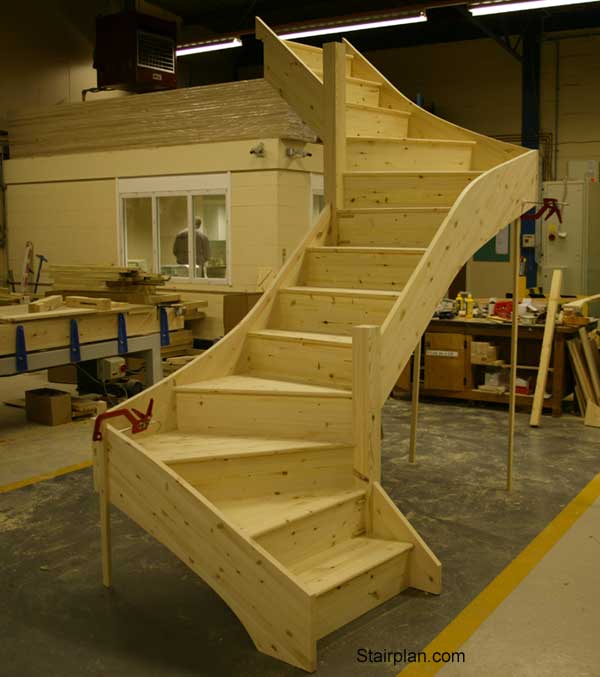I've got a Bosch 2HP 1617 EVS router with the Plunge Router option and the Bosch router table.
Just bought 2 new bits, both 1/2" shanked bits. One straight bit to clean up the treads before installing new bullnoses (biscuits and inside the mortised stringers) and a dovetail bit with a 7 degree taper.
I'm a rookie with the router, so I tend to be very conservative when it comes to over-engineering - Safety and Precision.
I've been using Patrick Spielman's Router Handbook as a guide on the Router's potential. When he gets to dovetail bits on long cuts, he recommends 'plowing out' the extra material with a straight bit first, which makes sense to me, to not overstress the dovetail bit.
The housed stringers on my two stairs will have laminated furniture grade 3/4" plywood for treads and 3/4" birch ply risers (I got a deal on the plywood, a couple years ago, and stored it in the house - (flat as glass now.) I'll use 1-1/2" X 1" thick oak to do the nosings with a medium dark stain and the treads in clear urethane. A runner will cover the center (24") of the 42" wide treads.
The dovetail bit is 5/8" diameter and has a 7/8" depth of cut (7 degree taper). I just want to cut into the stringers by 1/2" to set the treads and risers in. This will affect the template's edge, unless I make it from 1/2" Plywood at least, leaving only 1/8" for the collet to ride on. I've never seen a commercial template except in pictures, and the one I saw from England's Trend website looks like its 1/4" thick phenolic plastic (harder than plywood anyway).
The question on the template is should I use 5/8" plywood for the template, leaving 1/4" for the collet to follow, or make another template for the Straight bit to plow the big mortises first?
The second question is about the wedges. I'm making the wedges out of oak, on the tablesaw. The faces will be square. Logic tells me that with a 7 degree tenon to fill with glue, that it won't be an optimum bond to the stringer. Am I wrong? If so, how would I make only one side of these narrow wedges with a 6 or 7-degree face?
I may be making a mountain out of a molehill, but the Up Stairs have a 4 -step winder at the top, also house on the outside turn. I have to do a winder at the top, to clear the 45 degree pitch (12:12) on the roof and get the legal headroom. Easy enough with a 42 inch tread. But that also means that the 4 kite treads will need some solid support on the outside turn, in those mortises. And the wedges for those is just over 22" long. Am I worried for nothing about refacing the underside of the wedges to 7 degrees?
Just bought 2 new bits, both 1/2" shanked bits. One straight bit to clean up the treads before installing new bullnoses (biscuits and inside the mortised stringers) and a dovetail bit with a 7 degree taper.
I'm a rookie with the router, so I tend to be very conservative when it comes to over-engineering - Safety and Precision.
I've been using Patrick Spielman's Router Handbook as a guide on the Router's potential. When he gets to dovetail bits on long cuts, he recommends 'plowing out' the extra material with a straight bit first, which makes sense to me, to not overstress the dovetail bit.
The housed stringers on my two stairs will have laminated furniture grade 3/4" plywood for treads and 3/4" birch ply risers (I got a deal on the plywood, a couple years ago, and stored it in the house - (flat as glass now.) I'll use 1-1/2" X 1" thick oak to do the nosings with a medium dark stain and the treads in clear urethane. A runner will cover the center (24") of the 42" wide treads.
The dovetail bit is 5/8" diameter and has a 7/8" depth of cut (7 degree taper). I just want to cut into the stringers by 1/2" to set the treads and risers in. This will affect the template's edge, unless I make it from 1/2" Plywood at least, leaving only 1/8" for the collet to ride on. I've never seen a commercial template except in pictures, and the one I saw from England's Trend website looks like its 1/4" thick phenolic plastic (harder than plywood anyway).
The question on the template is should I use 5/8" plywood for the template, leaving 1/4" for the collet to follow, or make another template for the Straight bit to plow the big mortises first?
The second question is about the wedges. I'm making the wedges out of oak, on the tablesaw. The faces will be square. Logic tells me that with a 7 degree tenon to fill with glue, that it won't be an optimum bond to the stringer. Am I wrong? If so, how would I make only one side of these narrow wedges with a 6 or 7-degree face?
I may be making a mountain out of a molehill, but the Up Stairs have a 4 -step winder at the top, also house on the outside turn. I have to do a winder at the top, to clear the 45 degree pitch (12:12) on the roof and get the legal headroom. Easy enough with a 42 inch tread. But that also means that the 4 kite treads will need some solid support on the outside turn, in those mortises. And the wedges for those is just over 22" long. Am I worried for nothing about refacing the underside of the wedges to 7 degrees?







